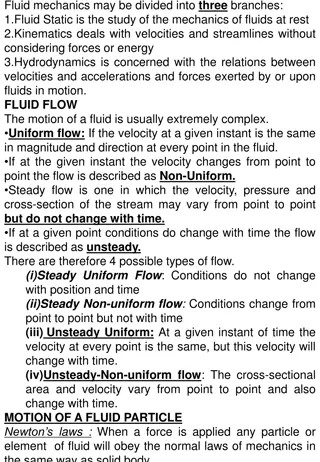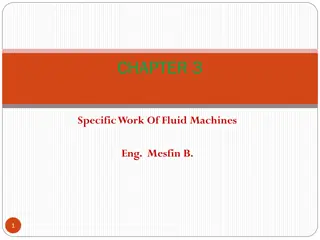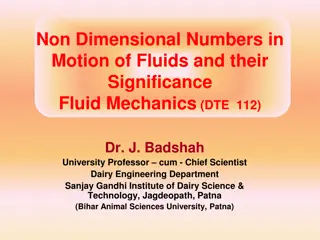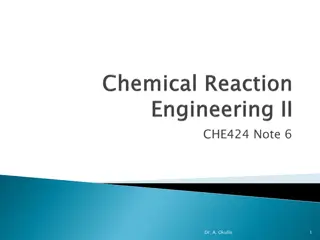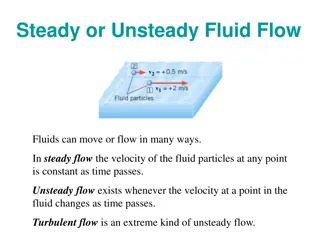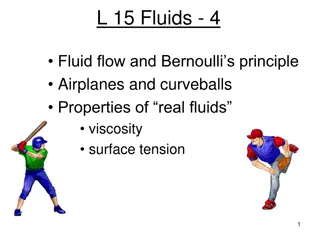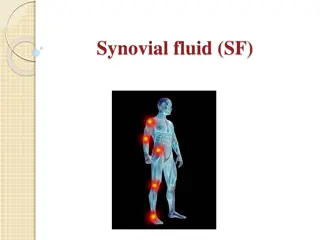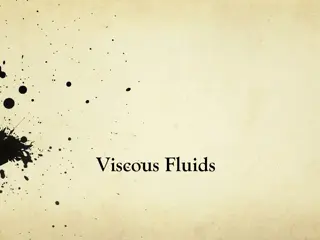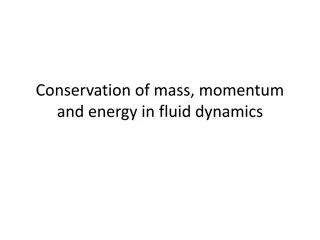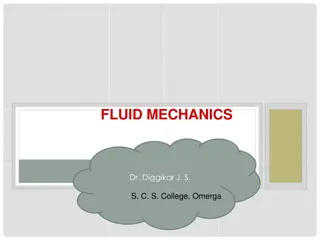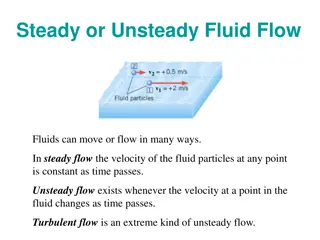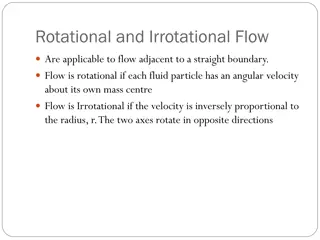Viscous Fluid Dynamics
Exploring the mathematical principles behind viscous fluids, including the Navier-Stokes equation, viscous stress tensor, and examples of fluid behavior. The lecture delves into the effects of viscosity on fluid motion and stresses. Equations for non-viscous fluids are contrasted with those for viscous fluids, elucidating key differences in fluid mechanics.
Download Presentation

Please find below an Image/Link to download the presentation.
The content on the website is provided AS IS for your information and personal use only. It may not be sold, licensed, or shared on other websites without obtaining consent from the author.If you encounter any issues during the download, it is possible that the publisher has removed the file from their server.
You are allowed to download the files provided on this website for personal or commercial use, subject to the condition that they are used lawfully. All files are the property of their respective owners.
The content on the website is provided AS IS for your information and personal use only. It may not be sold, licensed, or shared on other websites without obtaining consent from the author.
E N D
Presentation Transcript
StudyMafia.Org Factories Act 1948 Submitted To: Submitted By: Studymafia.org Studymafia.org
Table Contents Definition Introduction Objectives Labour- Legislations History Major Amendments Applicability Health and Safety Policy List of Notifiable Diseases Right of Workers How to Accomplish Conclusion
Definition Provisions envisaged are based on : - ILO convention and recommendations - Constitutional Provisions Directive Principles Fundamental Rights
Definition Central legislation enforced by the state government; In force since 1.4.1949 Social legislation 120 provisions spread-over under 11 chapters Act empowers state to make rules to enlarge the scope and objectives of the Act. Accordingly KFR 1969 is in force since 10.4.1969 Rules are also amended from time to time Extends to the whole of India Applicable to the premises, which comes under the definition Factory
Introduction Regarded as one of the Noble and a Comprehensive LabourLegislation which is inforce in our country. Covers all the aspects relating to workers employed in factories. Secures - Safety Health Welfare Regulates - Working Hours
Introduction Ensures - Annual leaves with wages Provides - Additional protection from hazardous processes Additional protection to women workmen Prohibition of employment of children
Objectives TO SECURE SAFETY OF THE PERSONS; TO SECURE HEALTH OF THE PERSONS FROM HAZARDOUS OCCUPATION/PROCESSES; TO ENSURE PROTECTION FROM HAZARDOUS EQUIPMENT; TO ENSURE SOUND WORKING ENVIRONMENT; TO ENSURE WELFARE OF THE PERSONS; TO PROTECT THE ENVIORNMENT;
Labour- Legislations OBJECTIVE - ENSURE PROTECTION TO LABOURERS PROTECTION Safety Health Industrial relations Working conditions Social security Environment Wages
Labour Legislations Legislations on Safety, environment, and working conditions : The Factories Act, 1948 The Indian Boilers Act, 1923 The Fatal Accident Act, 1855 The Indian Dock Labourers Act, 1934 Dock Workers (Regulation and Employment) Act, 1948 The Mines Act, 1952, etc.
History > 100 Years Old Legislation : Last two decades of the 18th century, i.e., 1880, 1890, 1900 Conditions : No control over the conditions of the employment of workmen employed in industries Employers used to bargain with the employees Child employment was predominant in factories Introduction of machines and new processes lead to accidents and deaths There was no stipulated timing of work
History Result is that the capitalist hopelessly exploited labourers These conditions urged the need for a law / legislation to protect the workers Result is the Indian Factories Act, 1881 came in to force. Much importance was given to abolish child employment by fixing the minimum age to 7 years Applicable for establishment having 100 workers; There were no inspecting staff; Initially, this didn t serve the purpose for which this has been designed.
History This was amended from time to time i.e., 1891, 1911, 1923, 1926, 1931, 1934 After the independence, highest concern was given to design a legislation to our independent India with an objective of protecting the workers employed in the factories. UK Factories Act, 1937 that was considered as an updated legislation to ensure the various aspects of workmen employed in factories was taken as base. This was also amended regularly, 1954, 1976, 1986
Major Amendments Reasons : Bhopal Gas tragedy occurred in 1984 (Early hours of 3.12.1984) Revealed the weakness in the existing law and demanded the need to amend the law by incorporating special provisions to deal with chemical industries and for management of chemical accidents. Act was overhauled 1987 (1.12.1987) Many provisions were introduced; Penal provisions were revamped
Major Amendments Hazardous process defined Hazardous Process means any process or activity in relation to an industry categorized wherein unless special care is taken, raw materials used therein or the intermediate products, bye-products, wastes or effluents would ; - Causes of material impairment to the health of the persons engaged in - Result in general pollution 29 industries have been listed as industries involving hazardous processes.
Applicability Limited jurisdiction applies to Factories Premises where 10 and more workers; Manufacturing process, Power Premises where 20 and more workers; Manufacturing process; No power Act empower state government to declare all or any of the provisions of the act to apply to any place with an objective to secure safety, health and welfare or workmen even though the workers strength is less than the above cited conditions. 1. Training of hides, 2. Electroplating, 3. Manufacturing of specific chemical substances, 4. Manufacturing of asbestos, 5. Storing and handling of chemical substances as listed under schedule 1 of MAH (K) Rules, 1994.
Applicability implementation of the provisions envisaged in the Act. OCCUPIER AND MANAGER are the responsible persons for OCCUPIER means the person who has got the ultimate control over the affairs of the factory. Proprietorship - Proprietor Partnership - One of the partner Company - One of the director MANAGER means a person responsible to the occupier for the working of the factory. He has to be nominated by the occupier.
Applicability Occupiers responsibility Inspectors responsibility Health Safety Welfare Working hours for adult workers Annual leave with wages Provisions strength of workers
Applicability Provisions - Women employment Provisions - Child labour Dangerous operations Notifiable diseases Special provisions relating to hazardous processes Accidents and dangerous occurrences Statutory notices, registers Right of workers Obligation of workers Penalties and procedures
Applicability Factories Act Women Workers Prohibits the employment of women from 7 pm to 6 am. Prohibits overtime work Act permits the Government to notify the factories to employ women workers up to 10pm with conditions Government has notified 15 categories of factories under 2 notifications;
Applicability Factories Act Women Workers The conditions are Written consent Free transport upto their residence 9 hours of rest after completion of work to the fresh period of work in the following day No overtime work Act bars employment of women workers from 10 pm to 5 am totally.
Applicability Factories Act Child Labour Bars the employment of persons below the age of 14 Act permits the employment of child and adolescent to work in factories subject to condition of obtaining certificate of fitness from the certifying surgeon. Child more than 14 and less 15; Adolescent more than 15 and less than 18 Working hour for child is four and half hour per day Double employment of child is prohibited Working hours for adolescent is as that of adult.
Health And Safety Policy Occupier should lay down a detailed policy with respect to the health and safety of the workers employed. The Health and Safety Policy should show The intentions and commitment of the management to provide SHE Organisational set up to bring out the policy effective Arrangement for involving the workers Intention of taking account of SHE performance in considering their career advancement Fixing responsibility on contractors
List Of Notifiable Diseases Poisoning by halogen or halogen derivatives Pathological manifestation Primary epitheliomatous cancer Toxic anemia Toxic jaundice due to poisonous substances Oil acne or dermatitis due to mineral oil Byssionosis Asbestosis Occupational or contact dermatitis due to chemical or paints
List Of Notifiable Disease Noise induced hearing loss Berlylium poisoning Carbon monoxide poisoning Coal miners pneumoconiosis Phosgene poisoning Occupational cancer Isocyanates poisoning Toxic nephritis
Right Of Workers Every workers shall have the right to Obtain from the occupier, information relating to workers health and safety at work Get trained within the factory wherever possible, or to get himself sponsored by the occupier for getting trained at a training centre or institute, duly approved the Chief Inspector of Factories, where training is imparted on safety, health and welfare. Represent to the Inspector directly or through his representative in the matter of inadequate provisions for protection of his health or safety in the factory.
How To Accomplish? Definitely much can be accomplished Top management should have very strong commitment to ensure safety and health at the workplace. Implementation of safety is not only a few persons job Everybody should think that individually and collectively they are responsible to promote safety in the industry It is not one time affair, it is continuous and constant Middle management should carry the mission and vision of the top management to the grass root level without any laxity and compromise. Continuous effort of providing information, training and education on safety and health to the persons who are in the field is required.
Conclusion The main objectives of the Indian Factories Act, 1948are to regulate the working conditions in factories, to regulate health, safety welfare, and annual leave and enact special provision in respect of young persons, women and children who work in the factories.
References Google.com Wikipedia.org Studymafia.org Slidespanda.com
Thanks To StudyMafia.org


